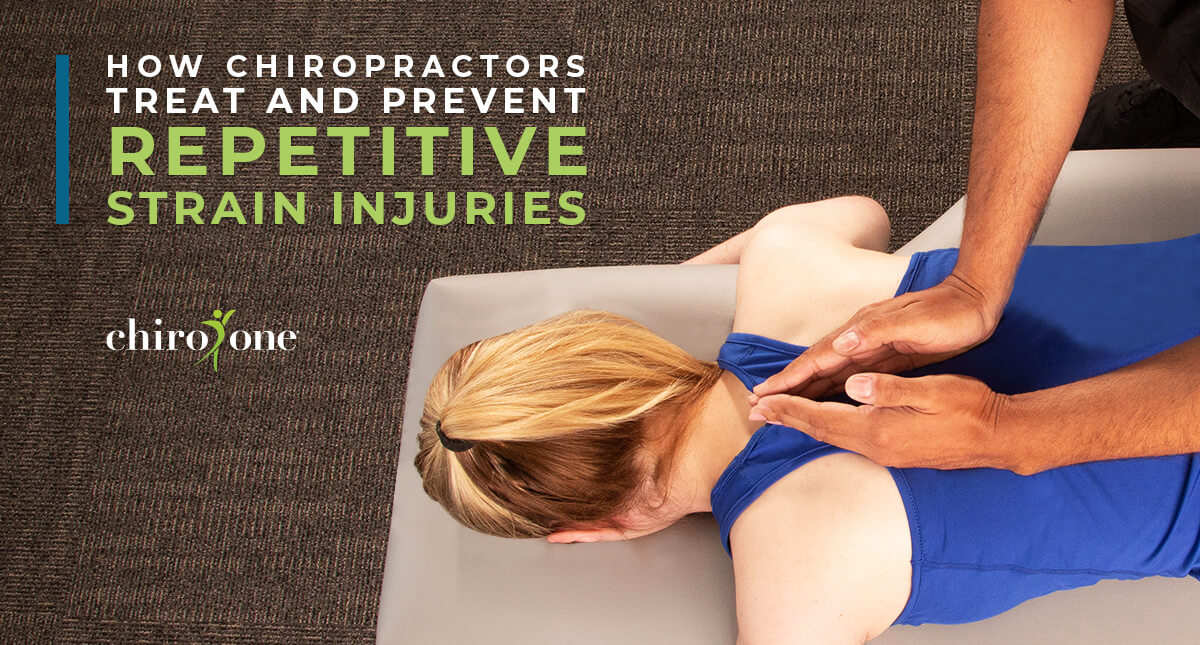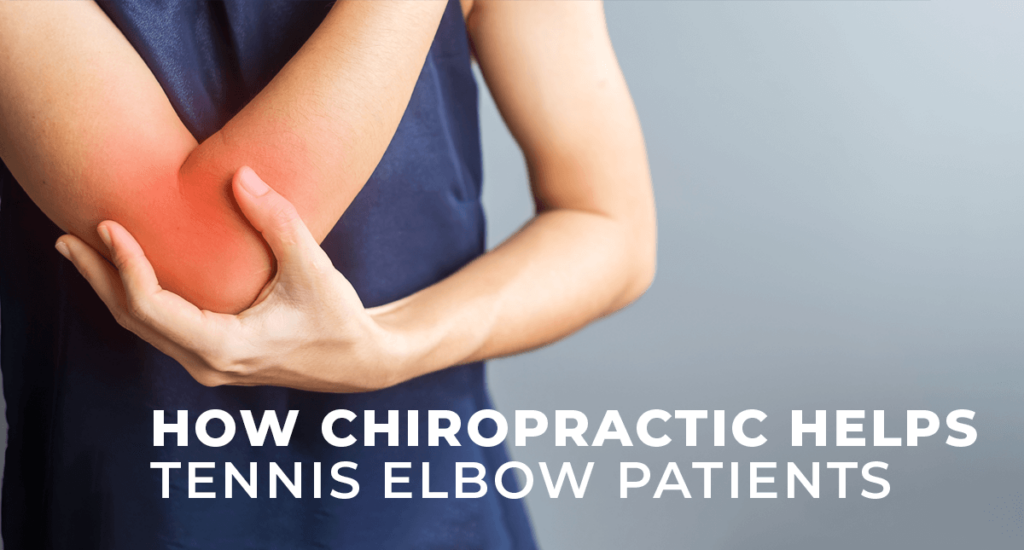
How Chiropractors Treat and Prevent Repetitive Strain Injuries
Chiropractic care helps treat and prevent repetitive strain injuries like Tennis Elbow, Carpal Tunnel Syndrome, and more. It an even help cut down your recovery time. Here’s how.

If you’re feeling pain in your elbow and forearm that sometimes radiates into your neck and shoulders, you may be struggling with a type of tendonitis commonly called tennis elbow. This musculoskeletal dysfunction causes more than 70,0001 people to miss work every year. If you’re one of them, read on to discover the causes, symptoms, prevention techniques as well as how chiropractic helps tennis elbow sufferers with proven diagnostics and treatments.
Despite its name, you don’t have to play tennis to get tennis elbow (a common form of tendonitis). In fact, most people who develop tennis elbow don’t — they just perform repetitive arm and hand movements which damage the lateral epicondyle tendon attached to the outside of the elbow, causing a repetitive strain injury.
Racquet sports players are at higher risk of developing tennis elbow, as are people in occupations that require vigorous forearm muscle use. Painters, plumbers, carpenters, auto workers, delivery and warehouse workers, cooks, butchers, hair stylists, massage therapists and even surgeons, are particularly prone to developing tennis elbow.
If you’re between the ages of 30 and 50 and your occupation requires repetitive movement or any amount of weightlifting with the forearm you are at heightened risk for tennis elbow. It’s a good idea to understand how chiropractic helps tennis elbow patients diagnose and manage this common condition.
Muscles, ligaments, and tendons hold your elbow joint together. It’s made up of three bones:
There are bony bumps at the bottom of the humerus called epicondyles. The bony bump on the outside of the elbow is called the lateral epicondyle. Your forearm muscles extend your wrist and fingers. Your forearm tendons — often called extensors — attach the muscles to bone on the lateral epicondyle. Your Extensor Carpi Radialis Brevis (ECRB) helps stabilize your wrist when your elbow is straight.
When your ECRB is weakened from overuse, microscopic tears form in the tendon where it attaches to the lateral epicondyle. This leads to inflammation and pain.
The ECRB may also be at increased risk for damage because of its position. As the elbow bends and straightens, the muscle rubs against bony bumps. This can cause gradual wear and tear of the muscle over time, so it’s good to know how chiropractic helps tennis elbow symptoms get diagnosed and managed.
The symptoms of tennis elbow develop gradually. In most cases, the pain is mild before slowly worsening over weeks and months. There is usually no specific injury associated with the start of symptoms (then they occur from an unknown cause the condition is called “insidious”).
If left untreated, pain and discomfort can last anywhere from three weeks to several years.
Tendonitis pain usually travels from the outer elbow, down the arm and to the wrist, however these symptoms can vary markedly in terms of their scope and severity:
In some cases, swelling can become so severe that the affected elbow appears much larger than the other.
For short-term pain and inflammation relief try the RICE method:
* If your pain and restriction don’t resolve within a couple of days you’ll need to see a specialist to prevent pain and discomfort from disrupting your lifestyle and exercise routine. Read on to learn how chiropractic helps tennis elbow patients diagnose and treat this common condition before it intensifies.
Chiropractic care offers a gentle conservative treatment for tennis elbow. First, your DC will examine your arm and spinal column to make sure your condition is, in fact, tennis elbow and not some other dysfunction (like joint infection – a very rare but serious condition requiring antibiotic treatment for which your DC will refer you to an MD).
Not every case of tennis elbow requires an elbow adjustment. In many cases, though, a misalignment of the elbow joint is causing certain muscles in the arm to compensate for that misalignment, causing that throbbing or stabbing pain and inflammation that brought you in.
To relieve your pain and revive the mobility you’re used to enjoying, your DC will customize a care plan targeting the location and severity of your injuries. It’s comprised of two elements:
To promote proper spinal alignment (which reduces pain and stiffness while improving mobility) your DC will apply gentle, controlled force to the wrist, elbow, shoulder, spine or a combination of areas that are not functioning optimally.
Chiropractic adjustments2 are hyper-targeted to reduce pain and nerve irritability, then increase range of motion by realigning your ligaments, tendons, and bones to improve your body’s function. Once they are lined up properly, your elbow will be in the optimal position for healing.
Clinical trials have demonstrated the relationship between tennis elbow pain and cervical pain and how chiropractic adjustment can help resolve both.
To support the adjustment, strengthen your muscles, improve your mobility and prevent a relapse of your pain, your DC will customize an active therapy protocol. Your assigned therapies and targeted stretches are geared at relieving inflammation and compression while preventing a relapse of your symptoms.
Your DC or your CT will demonstrate how to do them, then supervise you to ensure you’re performing them properly. Executing your active therapies is critical to your recovery and musculoskeletal health.
Randomized control trials have also shown that active therapies are highly effective at reducing pain, as well as improving strength and functional performance.
Your DC will advise you when it’s safe to return to your normal activities, such as exercise (or, well, tennis). Before you do so, your doctor may also show you how to adjust your biomechanics (the way you perform activities) in order to protect your muscles and tendons from reinjury. You can also prevent recurrence of your symptoms by:
The “no pain, no gain” approach can be dangerous, as it’s not always easy to distinguish between an ache that indicates you are building strength and an ache that means you’ve injured a tendon. That’s why it’s critical to find a highly experienced specialist to treat your pain and to explain how chiropractic helps tennis elbow root causes get resolved.
*Make sure you do not perform these exercises right after hydrotherapy (ice packs and heat pads)
To stretch long flexor tendons in fingers and thumb.
To strengthen wrist extensors and wrist flexors.
To strengthen your supinator muscle.
To stretch and strengthen your wrist extensor muscles.
Check in with your nearest Chiro One doc at one of our welcoming open-plan clinics across the country. They’ll explore the root cause of your pain with a thorough exam, then personalize a care plan — a combination of gentle chiropractic adjustments and active therapies.
Find a Chiro One doctor near you.
Source:
Subscribe and get news, articles & offers sent right to your inbox each month.
"*" indicates required fields
By subscribing you are agreeing to the Terms and Conditions and Privacy Policy.